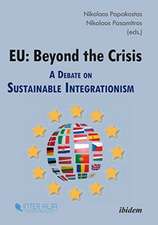Desert Regions: Population, Migration and Environment
Editat de Boris A. Portnov, A. Paul Hareen Limba Engleză Paperback – 5 oct 2011
Preț: 643.16 lei
Preț vechi: 756.65 lei
-15% Nou
Puncte Express: 965
Preț estimativ în valută:
123.08€ • 133.65$ • 103.39£
123.08€ • 133.65$ • 103.39£
Carte tipărită la comandă
Livrare economică 22 aprilie-06 mai
Preluare comenzi: 021 569.72.76
Specificații
ISBN-13: 9783642642883
ISBN-10: 3642642888
Pagini: 352
Ilustrații: XVI, 332 p.
Dimensiuni: 155 x 235 x 18 mm
Greutate: 0.49 kg
Ediția:Softcover reprint of the original 1st ed. 1999
Editura: Springer Berlin, Heidelberg
Colecția Springer
Locul publicării:Berlin, Heidelberg, Germany
ISBN-10: 3642642888
Pagini: 352
Ilustrații: XVI, 332 p.
Dimensiuni: 155 x 235 x 18 mm
Greutate: 0.49 kg
Ediția:Softcover reprint of the original 1st ed. 1999
Editura: Springer Berlin, Heidelberg
Colecția Springer
Locul publicării:Berlin, Heidelberg, Germany
Public țintă
ResearchDescriere
Despite the common understanding of the importance of desert development in the contemporary world, there are relatively few books published to date on this sub ject. The books and collective volumes published in this field deal primarily with environmental and physical aspects of desert development such as soil, agricul ture, vegetation, water resources, etc. In contrast, this book addresses the issues of regional and urban development in desert areas, which have not been given sufficient attention. The present book is socially oriented. It considers physical development of desert regions not as an end in itself, but rather as an essential precondition for creating socially attractive and desirable environments for human settlement. The book addresses the issues of desert development at three distinctive conceptual levels - region, urban envi ronment, and building -and deals with both cold and hot deserts. Approximately half of the chapters in this book are original contributions that have not been published elsewhere. The remaining chapters fall into two groups: 1) chapters which have been reprinted from various refereed journals, and 2) chapters initially printed elsewhere and revised by their respective authors specifi cally for this collective volume. In the former case, permission to reproduce the material has been obtained from the respective copyright holders, and the details of original publication and names of copyright holders are indicated in footnotes.
Cuprins
Preface.- List of Contributors.- 1 Introduction.- 1.1 Climate Causes of Aridity.- 1.2 Criteria for Aridity.- 1.3 Geographic Extent of Deserts.- 1.4 The process of Desertification.- 1.5 Desert and Urban Growth.- 1.6 Scope of the Book.- References.- One Regional Deveopment and Population Change.- 2 Long-tenn Development Patterns of Peripheral Desert Settlements.- 2.1 Introduction.- 2.2 Desert Urbanization in Israel: Prerequisites and Historical Background.- 2.3 Desert Settements: Exogenous Factors.- 2.4 Development Paradigms.- 2.4.1 Economic Development of Peripheral Desert Areas.- 2.4.2 Population Growth.- 2.5 Research Method.- 2.6 Development Popularities of Desert Settlements.- 2.7 Influence of the Desert.- 2.8 Conclusions and Policy Implications.- References.- 3 Sustainable Population Growth of Urban Settlements: Preconditions and Criteria.- 3.1 Introduction.- 3.2 Defining Sustainability.- 3.3 Measuring Population Growth.- 3.4 Urban Settlements in Israel: Inequalities in Population Growth.- 3.5 Patterns of Urbanization in Israel and General Development Policies.- 3.6 A Generalized Model of In-country Migrations.- 3.7 Research Method.- 3.8 Components of Population Growth.- 3.9 The MB/NG Ratio asan Integrated Indicator for Measuring the Sustainability of Population Growth.- 3.10 Factors Affecting Migration Attractiveness of Urban Areas.- 3.11 Conclusion and Policy Implication.- References.- 4 Private Construction as a General Indicator of Urban Development.- 4.1 Introduction.- 4.2 Private Contruction as Development Indicator.- 4.3 Private Construction in Israel: Historical Background and Spatial Trends.- 4.3.1 History of Private Constuction in Israel.- 4.3.2 Geographic Distribution of Private Construction in Israel: General Trends.- 4.4 Private Contruction in Hierarchy of Development Data.- 4.5 Location Paradigm.- 4.6 Case Study.- 4.7 Research Results.- 4.8 Application in Planning.- References.- 5 The Effect of Remoteness and Isolation on Development of Peripheral Settlements.- 5.1 Introduction.- 5.2 Sustainable Population Growth of Urban Settlements Components and Research Paradigms.- 5.2.1 Population Growth.- 5.2.2 Measuring Economic Development.- 5.3 Spatial Characteristics of Urban Development in Peripheral Areas.- 5.3.1 Distribution of Population and Settlement Location.- 5.4 Research Method.- 5.5 Controls.- 5.6 Analysis Procedure.- 5.7 Research Results.- 5.7.1 Population Growth.- 5.7.2 Index of Clustering.- 5.7.3 Climatic Harshness.- 5.8 Economic Development.- 5.9 Conclusions and Policy Implications.- References.- Modeling the Migration Attractiveness of a Region.- 6.1 Introduction.- 6.2 Employment and Housing Factors of Interregional Migration.- 6.3 Modeling the Migration Behavior.- 6.4 Housing-employment Paradigm of Interregional Migration.- 6.5 Israel and Japan: General Patterns of Regional Development.- 6.5.1 Patterns of Urbanization in Israel and Recent Development Policies.- 6.5.2 Current Issues of Regional and Urban Development in Japan.- 6.6 General Patterns of Interregional Migration.- 6.6.1 Israel.- 6.6.2 Japan.- 6.7 Research Method.- 6.8 Influencing Factors.- 6.9 Employment-housing Balance.- 6.10 Conclusion and Policy Implications.- References.- Investigating the Effect of Public Policy on Population Growth in Peripheral Areas.- 7.1 Introduction.- 7.2 Regional Policy Evaluation: Contemporary Trends.- 7.3 Research Methodology.- 7.4 Research Approach.- 7.5 Preliminary Results and Discussion.- 7.6 Modeling Procedure.- 7.7 Influencing Factors.- 7.8 Alternative Scenarios.- 7.9 Conclusion.- References.- Ecological-oriented Options for the Sustainable Development of Drylands.- 8.1 Desert and Development.- 8.2 Development of Hyperarid Drylands.- 8.3 Development of Arid Drylands.- 8.4 Development of Semiarid Drylands.- 8.5 Development of the Dry-Subhumid Drylands.- References.- Two Cities of Cold and Hot Deserts.- Physical Environment and Social Attractiveness of Frontier Settlements: Cities of Siberia, Russia.- 9.1 Introduction.- 9.2 Previous Research.- 9.3 The Region.- 9.4 The Cities.- 9.4 The Cities.- 9.5 Economics of Transition.- 9.6 Research Method.- 9.7 Spatial Patterns of District Attractiveness.- 9.8 Components of Attractiveness.- 9.9 Relative Importance of Influencing Factors.- 9.10 “Experts” and “Residents”: Different Visions.- 9.11 District Attractiveness to Business Activity.- 9.12 IP and the Market Value of Residential Land.- 9.13 Social Factors.- 9.14 Applications in Planning.- 9.15 Conclusion.- References.- Planning Theories versus Reality: A Desert Study Case.- 10.1 Introduction.- 10.2 A Short Note on Settlement in the Past.- 10.3 The Modern Era.- 10.3.1 Ottoman Period and the European Influences (1900–1917).- 10.3.2 Colonialism and British Mandate (1917–-1948).- 10.3.3 Suburban Agriculture of the First Israeli Period (1948–1950).- 10.3.4 Garden City and Neighborhood Unit (1950s).- 10.3.5 The New Master Plan and Design Experimentation (1960s).- 10.3.6 Prefabrication, High Rise Buildings and Traffic Separation (1970s).- 10.3.7 Satellite Ruruiban Development (1980s).- 10.3.8 Emergency Planning for Immigrants (the Early 1990s).- 10.4 Microclimatic Variability.- 10.5 Conclusions.- 10.6 Theory and Implementation.- References.- An Experimental Evaluation of Strategies for Reducing Airborne Dust in Desert Cities.- 11.1 Abstract.- 11.2 Introduction.- 11.3 Background.- 11.3.1 The Transport and Deposition of Dust in the Urban Environment.- 11.4 The Urban Climate.- 11.4.1 Temperature.- 11.4.2 Rainfall.- 11.4.3 Wind Regime.- 11.5 Experimental Sampling, Dust Deposits.- 11.5.1 Description of Sampling Locations.- 11.5.2 Field Methods.- 11.5.3 Laboratory Methods.- 11.6 Results.- 11.6.1 The Dust Deposition Rate.- 11.6.2 Grain Size Characteristics.- 11.6.3 Chemical and Mineralogical Composition.- 11.6.4 The Effects of a Major Dust Storm.- 11.7 Discussion.- 11.7.1 The Sources of Urban Dust in Desert Cities.- 11.7.2 The Effect of Common Design Strategies forReducing Exposure to Airborne Dust.- 11.7.3 Reducing Dust in Desert Cities — A Comprehensive Approach.- 11.8 Conclusion.- References.- Planning in Desert Environments: Three Cases of Responsive Planning.- 12.1 Introduction.- 12.2 Israel: Ideology and Planning.- 12.3 Settlement System.- 12.4 Town-planning.- 12.5 Bedouin Towns.- 12.6 Summary and Applications in Planning.- References.- The Past as a Key for the Future in Resettling the Desert.- 13.1 Introduction.- 13.2 A Lost Paradigm.- 13.3 The Rise and Decline of the Deterministic Paradigm.- 13.4 The Breaking Down of the Consensus.- 13.5 Conclusions with Regard to the Future.- Three Building and Design.- A Desert Solar Neighborhood in Sede Boker, Israel.- 14.1 Introduction.- 14.2 The Neighborhood.- 14.3 Orientation.- 14.4 Circulation.- 14.5 Building Clusters.- 14.6 Setback Lines.- 14.7 Water Heating.- 14.8 Conclusion.- References.- A Bio-Climatic Approach to Desert Architecture.- 15.1 The Climate of the Negev.- 15.2 Building Design: Sealing the Envelope.- 15.3 Windows: Opening the Envelope by Design.- 15.4 The Value of the Courtyard.- 15.5 Performance Monitoring.- Urban Microclimate in the Desert: Planning for Outdoor Comfort under Arid Conditions.- 16.1 Urban Attractiveness and the Desert Climate.- 16.2.1 Preconceived Planning in the Negev.- 16.2.2 Microclimatic Considerations.- 16.2 Case Study: Analyzing the Urban Microclimate.- 16.2.1 Summary of Case Study Results.- 16.2.2 Discussion: Creating the Urban “Cool Island”.- 16.3 Conclusions.- References.- Adaptive Architecture: Low-Energy Technologies for Climate Control in the Desert.- 17.1 Introduction.- 17.2 The Problem — Local Climatic Conditions.- 17.3 The Response: Project Overview.- 17.4 Experimental Evaluation of the Building’s Thermal Performance.- 17.4.1 The Sunken Atrium.- 17.4.2 The Evaporative Down Draft Cool Tower.- 17.4.3 Indirect Space Heating from Solar Heated Air.- 17.5 Conclusions.- References.- Four Case Studies.- Desert Settlements in Israel: Socio-Economic and Physical Data.- 18.1 Be’er-Sheva.- 18.2 Eilat.- 18.3 Dimona.- 18.4 Arad.- 18.5 Yeroham.- 18.6 Mitzpe-Ramon.- References.- Author Index.
Caracteristici
In contrast to other books on desert development, the book considers physical development of desert regions not as an end itself, but rather as an essential precondition for creating socially attractive and desirable environments for human settlement


















